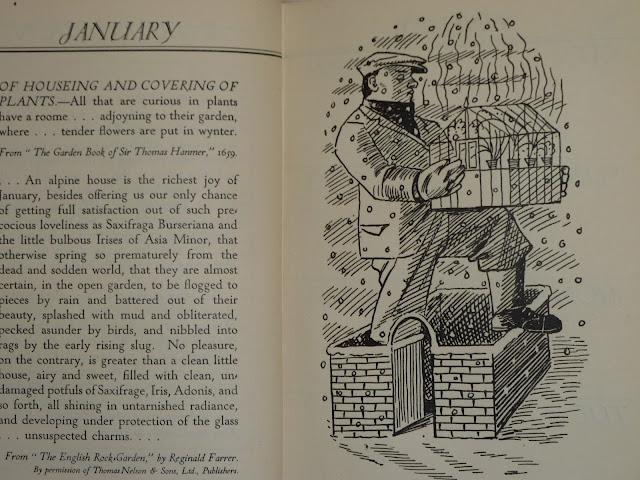Country Life 1938 Gardener's Diary: cover
It's ironic that this little book, among the lesser works Evelyn's career, and of which so few copies have survived, should have had such a strong influence on the direction of Evelyn's work from the late 1930s onwards. Diaries of this type tend to have a short afterlife: once their practical usefulness has come to an end they live on, if they live on at all, out of reach on top shelves, to gather dust in second-hand bookshops, until finally, unmourned and unregarded, they come to rest in the bin and finally the recycling centre. The copy shown above is lucky to have found a lasting home in the library of the Royal Horticultural Society, in Vincent Square, London. Here's the background.
In late 1933, having completed a postgraduate year at the Royal College of Art, Evelyn rented a newly refurbished studio at 99, South End Road, Hampstead, from Noel Carrington, writer, designer and publisher, eventually of Puffin books. At least part of Evelyn's reason for renting this top-floor studio was to provide an artistic roof not only over her head but also the head of Charles Mahoney, her recent RCA mural tutor and fast becoming her lover, who had no premises in which to work. Mahoney and Evelyn were working on an extensive project, the Brockley murals, featured in some depth here.
Her presence in Hampstead also allowed Evelyn to keep up with that coterie of creative spirits which the writer and art critic Herbert Read was later to call a 'gentle nest of artists'. The 'gentle nest' rivalled Bloomsbury in the variety and quality of its nestlings. One such, until he retired as Principal of the RCA, was Sir William Rothenstein, for whom Evelyn was a favoured protégée; another was Noel Carrington. It was through Carrington's intermediary that Evelyn was commissioned to provide a set of decorative drawings for The Scots Weekend, a dip-into miscellany compiled by Glasgow exiles Donald and Catherine Carswell, two further Hampsteadians. It was her first such venture.
Mahoney, no great Hampstead socialite, led Evelyn into the ambit of another coterie, initially through his involvement with the garden and its design at Brick House, Great Bardfield, in Essex. This house was shared between the artists Edward Bawden and Eric Ravilious, with their respective wives Charlotte and Tirzah. Both artists - together with Mahoney - were tutors at the RCA, appointed as young bloods to ginger up the teaching staff by Rothenstein in the late 1920s, although neither taught Evelyn. By the time in the mid-1930s that Evelyn and Mahoney had become such frequent house guests at Brick House that they were nicknamed 'Adam and Eve', the Raviliouses had moved elsewhere. In a sense Evelyn had become a link between Hampstead and Great Bardfield. The link, such as it was, did not last beyond Evelyn's and Mahoney's separation in September 1937.
In addition to his other activities Noel Carrington worked for the magazine Country Life, commissioning, editing and publishing its various satellite publications. Great Bardfield was closely involved: Ravilious produced the Country Life Cookery Book in 1937; in 1936 Bawden was commissioned to prepare the Country Life Gardener's Diary for the following year; and Evelyn was commissioned in 1937 to prepare and illustrate the Country Life 1938 Gardener's Diary.
* * *
To some extent Evelyn modelled her Gardener's Diary on Bawden's of the previous year, providing space for observations, reminders and remarks about the weather - not featured here - interleaved with richly subtle and imaginative pen-and-ink personifications of the months of the year, many engaged in seasonal activities, together with suitable gardening quotes from a wide sweep of sources, ranging from the biblical Book of Job to the late 19th century socialist horticulturalist Shirley Hibberd (a man, but I'm sure you knew this already.). The illustrations of the months are the book's greatest delight; such was surely Evelyn's pleasure with the images that appeared from the end of her pen that she later worked some of her creations up into oils. There was a darker side, however: some of her images have secondary, autobiographical levels. They testify to hard, not to say cruel times following Mahoney's abandonment of her, and the beginning of what she called her 'crisis years', 1937-1940. One has only to look at April's hat to conclude that something very strange is happening.
Here are the complete months. The occasional links take you to essays on Evelyn's later oil versions. There are echoes of one or two of the months, for instance January below, in her An English Calendar of 1938.
Sincerest thanks to the Royal Horticultural Society for permission to photograph the Country Life 1938 Gardener's Diary.
Text ©Christopher Campbell-Howes 2024. All rights reserved.
by Christopher Campbell-Howes
is available to order online from:
448 pages, 301 illustrations. RRP £30






















